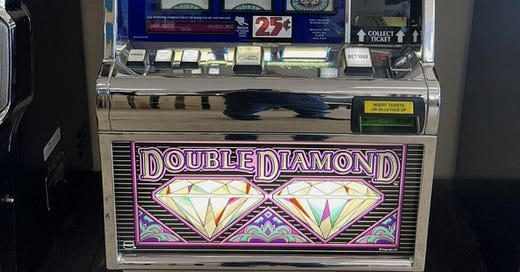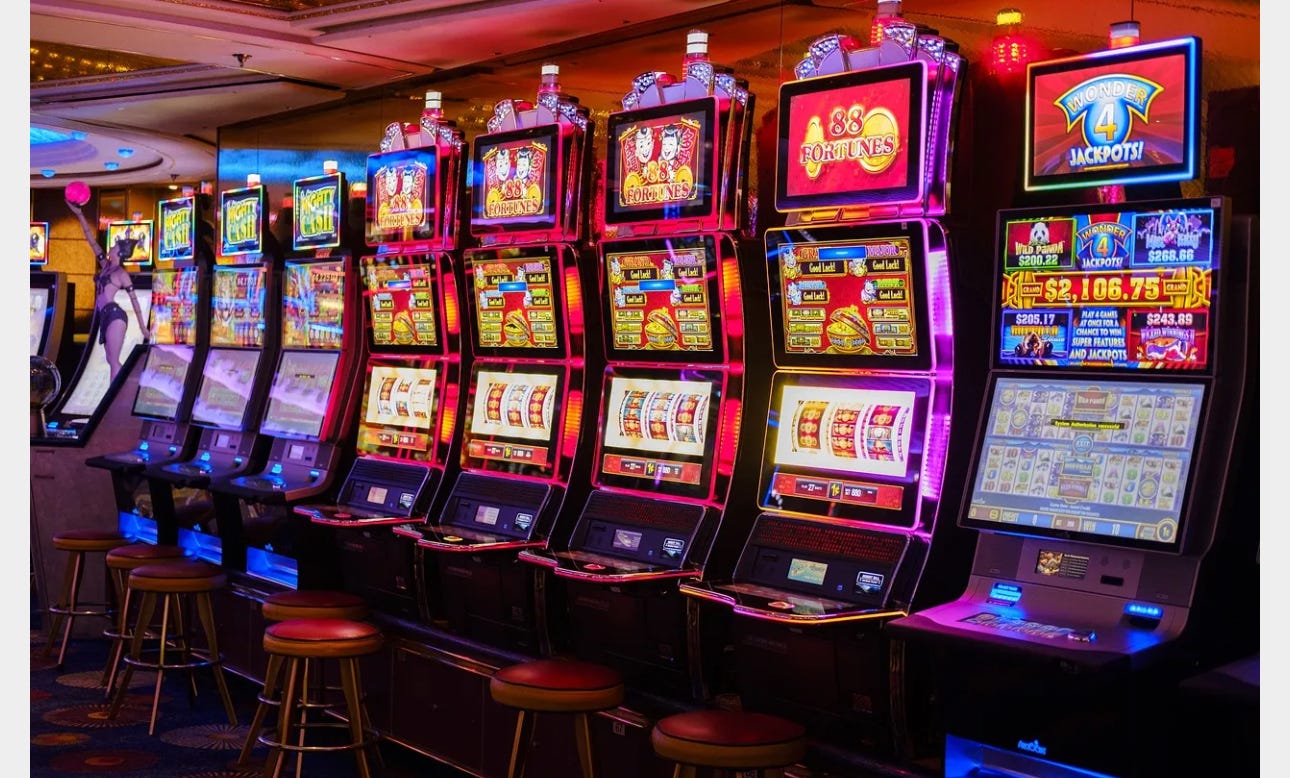On the rise - and risks - of machine gambling (Part 1 of 2)
Coming soon to an iPhone near you
FIRST OF TWO PARTS
Addiction comes in many flavors.
But some grab our attention more than others. Drug (and alcohol) addicts tend to be young, noisy, and male. They’re frequently dangerous. So society spends a huge amount of time dealing with and thinking about them.
Almost as much time as they spend thinking and talking about themselves. For drug users are often eager to tell the world about the devil’s waltz they’ve cued - at least early on. In Xanadu did Kubla Khan a stately pleasure dome decree, blah blah blah…
Then there are those poor forgotten souls stuck on slot and video gambling machines.
—
(Triple-7s for the truth, with your help!)
—
In a brilliant book called Addiction by Design: Machine Gambling in Las Vegas, which has only become more relevant since its 2012 publication, an anthropologist named Natascha Dow Schüll explored the quiet, brutal compulsions of screen-based gambling (the machines called slots mostly now use graphics, not mechanical reels).
Device addicts are very different demographically than drug addicts, or even other compulsive gamblers. They are often middle-aged or older women. They gamble differently, too. At the tables, gamblers cheer together when a blackjack dealer hits a 16 and busts. But slot players sit alone before the machines they cherish, silently tapping the play button over and over. As their money vanishes. And they do too.
They play, Schüll shows, not to win but to escape. Or more accurately to disappear.
They play to play. They want to win not to make money but so they can play longer. Sometimes, astonishingly, they don’t even seem to want to win, at least not big. Big wins can interrupt their playing rhythm, and they don’t want to be interrupted.
Once they sit down, many basically cannot leave until they run out of money (and access to money, conveniently available at the ATMs scatted all over casinos). However many hours that takes.
—
(They don’t look like this any more…)
—
In the last generation, casinos and device makers have made enormous technological changes (I cannot bring myself to call them improvements) to their machines to make them better at taking gamblers’ money.
But, as Schüll explains, arguably the most important innovation in machine gaming since the invention of the original slot machine was the creation of “multiline” devices that take, manage, and pay out scores of different bets simultaneously.
Instead of betting a dollar on the single pull of a handle, a gambler could split her wager into 100 different penny-sized wagers at once. Slot machines originally offered a single “payline” - if the 7s or cherries lined up on the centerline, the play won.1 Now they could pay out bets horizontally, vertically, and diagonally on a single virtual spin.
Why did this change matter so much?
It ensured that at least a few of those tiny bets were likely to hit, enabling the machine to reinforce the gambler’s desire for a successful spin - a win. Yet the overall win would be less than the size of the original overall bet.
Divide your dollar into 100 bets, push the button, watch the video reels spin. Congrats! One of your penny bets has a 10-for-1 payoff, another is 30-for-1, two others 5-for-1. The lights are flashing, the music is playing. You won, lucky gambler.
Except you started with a dollar, and ended with 50 cents.
And because they resolve bets digitally rather than mechanically (using computerized random number generators whose output went to virtual video reels), video poker and video slot machines can handle an incredibly fast pace of betting.
—
(…they look like this.)
—
How fast?
Modern video gaming devices can take bets every three or four seconds, basically just enough time to “spin” their on-screen wheels and tell players if they have won. With multiline devices, bettors rarely try to calculate payouts for themselves. Doing so takes too long. They simply assume the device is correct, the same way that almost no one who goes to Wal-Mart bothers to add up the receipt.
The math is extraordinary: 100 one-penny bets every four seconds equals 1500 bets a minute, 360,000 over a four-hour session. 360,000 separate bets! That unthinkably large number translates into a total of $3600 waged. A typical penny-slot machine has an 11 percent “hold” - keeping 11 cents from each dollar gambled.
So, playing penny slots, a gambler will lose about $400 on average in that four-hour session — $3600 times 0.11.
And because the gambler is making so many bets, and the hold is so large (table games like blackjack typically have a much smaller house edge, ranging from 1 to 5 percent), she has almost no chance of overcoming the machine’s natural variance even in a single session.2
Yes, decreasing bet size actually makes the machine better at taking gamblers’ money in the long run. They are almost never going to get up big early on - betting a dollar and winning $1000, say - thus giving them the chance to walk away having banked a win that might let them settle their losses from a couple of previous casino trips.
At the same time, they are unlikely to have very short, sharp losing sessions. As the game designers - and the gamblers themselves - explained to Schüll, bettors simply ride the machine all the way down, with relatively small fluctuations along the way.
It may seem extraordinary that this slow burn to an empty wallet is the experience machine gamblers prefer, but video poker and penny multiline video slots now fill casinos.
Speed, repetition, and a convenient video screen you can see and touch up close, combining to produce a deep addiction.
Sound like anything else that’s recently become a part of your life?
(END OF PART ONE)
In fact, even before the multiline machines, the move to slot machines with random number generators and “virtual reels” instead of mechanical reels meant that device makers could tweak the results of single-line games in ways that made them seem far more likely to hit than they actually were. The close calls also increased their addictiveness.
About her only chance to do so is to win a lottery-like progressive jackpot, built by putting a fraction of each bet from hundreds or thousands of network machines; but jackpots of that size have Powerball-type odds, tens or hundreds of millions to one.






The root of the problem was making gambling legal at all - then it went into every locale and venue possible often under the guise of the good things it would support with related taxes and economic activity. Then our “safety net” feeds, clothes and houses many folks who still have money for gambling, cigarettes, tattoos, piercings, drugs and alcohol.
This is an addiction I can understand. I have downloaded and deleted Candy Crush, after getting to very high levels, numerous times on my phone because once I started paying for boosters, I knew it was a problem. No more of that for me!